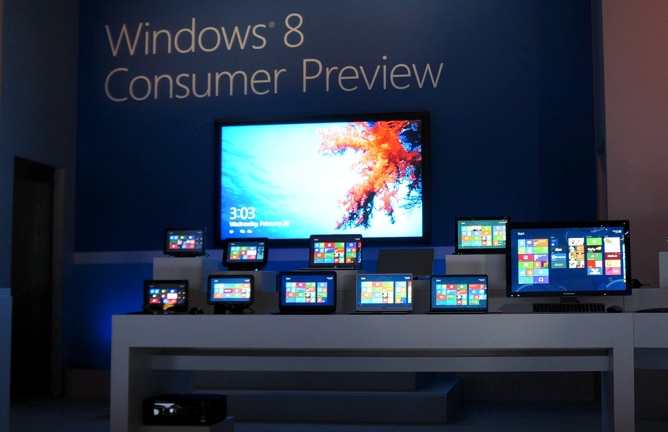Big and small, Microsoft has some pretty major plans for Windows 8.
[aditude-amp id="flyingcarpet" targeting='{"env":"staging","page_type":"article","post_id":461173,"post_type":"story","post_chan":"none","tags":null,"ai":false,"category":"none","all_categories":"business,mobile,offbeat,","session":"A"}']On the larger end of the spectrum is the hulking 80-inch tablet that Microsoft CEO Steve Ballmer keeps in his office. The display, which is likely similar to the one seen in the background of the photo above (from Microsoft’s Windows 8 preview event several months ago), has allowed Ballmer get rid of his phone and note paper, Microsoft VP Frank Shaw told Wired UK.
The existence of the device is fueled by Microsoft’s desire to make pretty much every screen a computer, “Every screen should be touch, every screen should be a computer and should be able to see out as well as see in. That is the way the world is heading [and] those screens are going to be big, small, wall-sized and desk-sized,” Shaw told Wired.
AI Weekly
The must-read newsletter for AI and Big Data industry written by Khari Johnson, Kyle Wiggers, and Seth Colaner.
Included with VentureBeat Insider and VentureBeat VIP memberships.
Microsoft says that it has no plans to directly sell such a large device, but that it’s very possible that third-party vendors will pick up the slack. If anything, it proves that Windows 8 can scale from netbooks and tablets, to giant screens.
The notion should sound a bit familiar. Microsoft’s previous attempt at a similarly large display came with Microsoft Surface, touch-enabled tabletop that, while impressive, hasn’t quite hit the mainstream consumer yet.
VentureBeat's mission is to be a digital town square for technical decision-makers to gain knowledge about transformative enterprise technology and transact. Learn More

